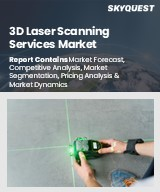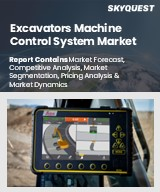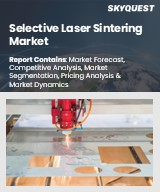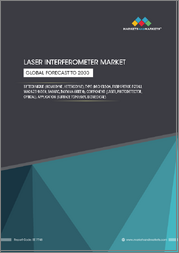
|
시장보고서
상품코드
1809766
광 주파수 빗 시장 : 구성요소, 파장 대역, 용도, 최종사용자별 - 세계 예측(2025-2030년)Optical Frequency Combs Market by Component, Wavelength Band, Application, End User - Global Forecast 2025-2030 |
||||||
광 주파수 빗 시장의 2024년 시장 규모는 2억 294만 달러로 평가되었으며, 2025년에는 2억 1,311만 달러로 성장하여 CAGR은 5.28%, 2030년에는 2억 7,636만 달러에 달할 것으로 예측됩니다.
| 주요 시장 통계 | |
|---|---|
| 기준 연도 2024년 | 2억 294만 달러 |
| 추정 연도 2025년 | 2억 1,311만 달러 |
| 예측 연도 2030년 | 2억 7,636만 달러 |
| CAGR(%) | 5.28% |
광 주파수 빗의 선구자 : 초정밀 분광학 및 통신 기술의 혁명적 기반 공개
광 주파수 빗은 정밀 측정 및 광대역 분광학에서 가장 혁신적인 도구 중 하나로 등장하여 빛을 이해하고 조작하는 우리의 능력을 근본적으로 변화시켰습니다. 초고속 레이저 물리학과 광학 계측학의 교차점에서 탄생한 이 장치는 미지의 파장을 탁월한 정확도로 측정하기 위한 광학 '눈금자' 역할을 하는 이산적이고 균등하게 간격을 둔 주파수 선의 스펙트럼을 생성합니다. 이 장치의 발명은 원자시계부터 환경센싱에 이르기까지 다양한 분야에서 획기적인 발전을 가져왔으며, 과거에는 불가능하다고 여겨졌던 해상도와 안정성을 실현했습니다.
광 주파수 빗의 새로운 돌파구는 칩 스케일 집적화와 광범위한 스펙트럼 커버리지를 이용하여 포토닉스를 재정의하고 있습니다.
광 주파수 빗 기술의 정세는 소형화 및 집적화의 획기적인 발전으로 패러다임의 전환이 일어나고 있습니다. 기존의 탁상용 콤 시스템은 칩 스케일 마이크로 공진기 플랫폼으로 대체되어 실리카 및 실리콘 질화물의 비선형 공정을 활용하여 광칩에서 직접 콤 스펙트럼을 생성하게 되었습니다. 이러한 전환은 크기와 전력 소비를 줄일 뿐만 아니라 대량 생산의 길을 열어 통신 및 센싱 애플리케이션에 폭넓게 적용될 수 있도록 합니다.
2025년 미국 관세가 광 주파수 빗의 공급망과 혁신 생태계에 미칠 파급효과 평가
2025년 미국의 광학 및 반도체 부품에 대한 관세 인상은 전 세계 공급망에 큰 파장을 불러일으키고 있습니다. 초고속 모드 잠금 레이저, 양자 캐스케이드 장치, 고정밀 전기광학 변조기 등의 부품은 비용 상승으로 인해 OEM 및 시스템 통합업체는 조달 전략을 재검토해야 하는 상황에 처해 있습니다. 이러한 관세의 누적된 영향은 가격 압박을 가중시키고, 장기 공급 계약의 협상과 경우에 따라서는 관세 면제 지역으로 조립 작업의 이전으로 이어지고 있습니다.
광 주파수 빗 시장을 형성하는 구성요소 파장 응용 분야 및 최종사용자에서 중요한 세분화 역학을 해독합니다.
임계 세분화 분석을 통해 위상 및 진폭 제어를 위한 전기광학 변조기는 여전히 필수적이며, 마이크로 공진기 솔루션은 품질 계수 및 집적 가능성을 최적화하는 석영 및 실리콘 질화물 플랫폼을 통해 주목을 받고 있으며, 모드 잠금 레이저는 섬유와 솔리드 스테이트 아키텍처 모두에 걸쳐 전통적인 컴 생성의 중추를 계속 형성하고 있습니다. 반면, 양자 캐스케이드 레이저는 첨단 센싱 애플리케이션에 필수적인 중적외선 파장에 직접 접근할 수 있도록함으로써 또 다른 방향을 제시하고 있습니다.
광 주파수 빗 기술 채택 및 혁신 촉진,아메리카, 유럽, 중동 및 아프리카, 아시아태평양의 지역별 성장
광 주파수 빗의 전략적 전망을 형성하고 있는 것은 지역적 역동성입니다. 미국 대륙에서는 정부의 강력한 자금 지원 이니셔티브와 국립 연구소와 민간 혁신가들의 긴밀한 협력으로 인해 컴 기술의 상용화가 가속화되고 있습니다. 미국과 캐나다의 실리콘 포토닉스 파운드리는 마이크로 공진기 집적화를 우선순위에 두고, 스타트업과 기존 기업을 모두 지원하고 있습니다.
광 주파수 빗 분야의 성장을 가속화하는 주요 혁신 기업의 상세 프로필 및 전략 소개
광 주파수 빗 솔루션의 경쟁 구도는 레거시 포토닉스 제조업체와 집적화의 최전선에서 민첩한 도전자들이 혼재되어 있는 것이 특징입니다. 오랜 전통을 자랑하는 이 회사는 수십 년간의 레이저 개발 전문성을 바탕으로 모드 잠금 시스템 및 양자 캐스케이드 광원을 개선하고 전략적 인수 및 연구 제휴를 통해 포트폴리오를 확장해 왔습니다. 동시에, 포토닉스 전문 기업은 마이크로 공진기 제조의 틈새시장을 개척하고 모듈식 고Q 플랫폼을 제공함으로써 채널당 비용과 필요한 전력을 줄였습니다.
업계 리더들이 광 주파수 빗 기술의 새로운 기회를 활용하고 과제를 극복하기 위해 실행 가능한 전략을 실행할 수 있습니다.
업계 리더는 포토닉의 전문성과 시스템 수준의 통합 능력을 연결하는 파트너십을 우선시하고, 연구 강도를 최종사용자의 요구 사항에 맞게 조정해야 합니다. 차세대 재료와 광 주조 서비스에 투자함으로써 기업은 공급망 취약성을 완화하고 칩 스케일 마이크로 공진기 컴의 성숙을 가속화할 수 있습니다. 동시에 국방, 의료, 통신 생태계 간의 제휴를 통해 공동 개발의 기회를 촉진하고, 새로운 양식이 고객의 절박한 고통에 대응할 수 있는 새로운 양식을 확보할 수 있습니다.
1차 전문가 인터뷰와 2차 데이터 분석 및 삼각측량을 결합한 조사 방법을 통해 광주파수 통신 시장에 대한 정확한 인사이트를 얻을 수 있습니다.
이 분석은 깊이와 신뢰성을 모두 보장하기 위해 설계된 다각적인 조사 접근 방식에서 도출된 인사이트를 통합합니다. 1차 조사에서는 포토닉스 기업, 방위 관련 기업, 학술 연구소의 고위 임원, 연구 책임자, 조달 전문가를 대상으로 구조화된 인터뷰를 실시했습니다. 이러한 대화를 통해 기술 로드맵, 예산 제약, 전략적 우선순위에 대한 직접적인 관점을 얻을 수 있었습니다.
산업을 초월한 광 주파수 빗 혁신의 전략적 중요성과 미래 궤적을 강조하는 결론 도출
광 주파수 빗은 정밀 측정, 고속 통신, 첨단 센싱의 결절점에 위치하여 기초 과학과 산업 응용의 보기 드문 융합을 제공합니다. 이 기술은 실험실에서의 호기심에서 다양한 분야로 확장 가능한 핵심 기술로 진화하고 있으며, 그 전략적 중요성이 강조되고 있습니다. 부품의 기술 혁신과 통합 전략으로 진입 장벽이 계속 낮아지는 가운데, 이해관계자들은 무역 정책의 변화와 공급망의 복잡성에 대한 경계를 늦추지 않아야 합니다.
목차
제1장 서문
제2장 조사 방법
제3장 주요 요약
제4장 시장 개요
제5장 시장 역학
제6장 시장 인사이트
- Porter's Five Forces 분석
- PESTEL 분석
제7장 미국 관세의 누적 영향 2025
제8장 광 주파수 빗 시장 : 구성요소별
- 전기광학 변조기
- 마이크로 공진기
- 실리카 마이크로 공진기
- 질화 실리콘 마이크로 공진기
- 모드 락 레이저
- 파이버 레이저
- 고체 레이저
- 양자 캐스케이드 레이저
제9장 광 주파수 빗 시장 : 파장대별
- 중적외선
- 근적외선
- 가시
제10장 광 주파수 빗 시장 : 용도별
- 바이오메디컬 이미징 및 진단
- 방위
- 레이저 대책
- 광검출과 측거(LiDAR)
- 주파수계측
- 분광법
- 통신
제11장 광 주파수 빗 시장 : 최종사용자별
- 방위 기관
- 산업 제조업체
- 의료 시설
- 연구기관
- 통신사업자
제12장 아메리카의 광 주파수 빗 시장
- 미국
- 캐나다
- 멕시코
- 브라질
- 아르헨티나
제13장 유럽, 중동 및 아프리카의 광 주파수 빗 시장
- 영국
- 독일
- 프랑스
- 러시아
- 이탈리아
- 스페인
- 아랍에미리트
- 사우디아라비아
- 남아프리카공화국
- 덴마크
- 네덜란드
- 카타르
- 핀란드
- 스웨덴
- 나이지리아
- 이집트
- 튀르키예
- 이스라엘
- 노르웨이
- 폴란드
- 스위스
제14장 아시아태평양의 광 주파수 빗 시장
- 중국
- 인도
- 일본
- 호주
- 한국
- 인도네시아
- 태국
- 필리핀
- 말레이시아
- 싱가포르
- 베트남
- 대만
제15장 경쟁 구도
- 시장 점유율 분석, 2024
- FPNV 포지셔닝 매트릭스, 2024
- 경쟁 분석
- AOSense, Inc.
- Exail SAS
- IMRA America, Inc.
- MENLO SYSTEMS GmbH
- NKT PHOTONICS A/S by Hamamatsu Photonics KK
- SIMTRUM Pte. Ltd.
- Thorlabs, Inc.
- TOPTICA Photonics AG
- Vescent Technologies, Inc.
- Novanta Inc.
제16장 리서치 AI
제17장 리서치 통계
제18장 리서치 컨택트
제19장 리서치 기사
제20장 부록
KSM 25.09.23The Optical Frequency Combs Market was valued at USD 202.94 million in 2024 and is projected to grow to USD 213.11 million in 2025, with a CAGR of 5.28%, reaching USD 276.36 million by 2030.
| KEY MARKET STATISTICS | |
|---|---|
| Base Year [2024] | USD 202.94 million |
| Estimated Year [2025] | USD 213.11 million |
| Forecast Year [2030] | USD 276.36 million |
| CAGR (%) | 5.28% |
Pioneering Optical Frequency Combs: Unveiling a Revolutionary Foundation for Ultra-Precise Spectroscopy and Communication Technologies
Optical frequency combs have emerged as one of the most transformative tools in precision measurement and broadband spectroscopy, fundamentally altering our capacity to understand and manipulate light. Born from the intersection of ultrafast laser physics and optical metrology, these devices generate a spectrum of discrete, equally spaced frequency lines that serve as an optical "ruler" for measuring unknown wavelengths with unparalleled accuracy. Their invention has spurred breakthroughs in fields ranging from atomic clocks to environmental sensing, delivering resolution and stability once thought impossible.
As industries push toward ever-greater demands for precision and bandwidth, the role of optical frequency combs continues to expand. In telecommunications, they enable coherent data transmission at terabit rates; in fundamental research, they underpin tests of physical constants; and in healthcare, they promise new horizons in noninvasive diagnostics. These innovations serve as the foundation for a rapidly evolving ecosystem, setting the stage for the shifts and strategic considerations explored in the subsequent sections.
Emerging Breakthroughs in Optical Frequency Combs That Are Redefining Photonics by Harnessing Chip-Scale Integration and Broad Spectrum Coverage
The landscape of optical frequency comb technology has undergone a paradigm shift driven by breakthroughs in miniaturization and integration. Traditional tabletop comb systems gave way to chip-scale microresonator platforms, which leverage nonlinear processes in silica and silicon nitride to generate comb spectra directly on a photonic chip. This shift not only reduces size and power consumption but also paves the way for mass manufacturability, enabling broader deployment across telecom and sensing applications.
Simultaneously, advances in mid-infrared comb sources and quantum cascade laser architectures are extending the accessible wavelength range, unlocking potent new capabilities for molecular fingerprinting and environmental monitoring. Coupled with innovations in integrated modulators and feedback stabilization techniques, these developments are orchestrating a deeper convergence between photonic hardware and data-driven control systems. As a result, stakeholders across research institutions, medical facilities, and defense agencies are adjusting strategies to align with this next generation of compact, versatile comb platforms.
Assessing the Far-Reaching Consequences of United States Tariffs in 2025 on the Optical Frequency Comb Supply Chain and Innovation Ecosystems
In 2025, the imposition of increased tariffs on photonic and semiconductor components by the United States has generated notable ripples across global supply chains. Components such as ultrafast mode-locked lasers, quantum cascade devices, and precision electro-optic modulators have seen elevated costs, prompting OEMs and system integrators to reevaluate sourcing strategies. The cumulative effect of these duties has intensified pressure on pricing, leading to negotiations for long-term supply contracts and, in some cases, relocation of assembly operations to tariff-exempt regions.
Moreover, research budgets at academic and federal institutions have been redirected to account for these additional expenses, slowing the pace of certain experimental initiatives. Concurrently, companies are pursuing dual-sourcing models and exploring alternative materials and fabrication methods to mitigate the impact of trade barriers. In an era where rapid innovation is critical, the ability to navigate this shifting economic terrain has become a defining competency for both established photonics leaders and emerging challengers.
Decoding Critical Segmentation Dynamics in Component Wavelength Application and End User Dimensions Shaping the Optical Frequency Comb Market
Critical segmentation analysis reveals distinct trajectories across the component dimension, where electro-optic modulators remain essential for phase and amplitude control, microresonator solutions capture attention through silica and silicon nitride platforms that optimize quality factors and integration potential, and mode-locked lasers-spanning both fiber and solid-state architectures-continue to form the backbone of traditional comb generation. Quantum cascade lasers, on the other hand, set a separate course by providing direct access to mid-infrared wavelengths crucial for advanced sensing applications.
Examining wavelength bands underscores a well-defined spectrum of opportunity. Near-infrared systems benefit from existing fiber infrastructure and established integration paths, while visible combs address emerging requirements in precision spectroscopy and biomedical imaging. The mid-infrared sector, buoyed by novel materials and quantum cascade developments, holds immense promise for molecular detection in industrial and environmental contexts.
Application segmentation further highlights the interplay between science and defense, where biomedical imaging and diagnostics exploit comb-based coherence for noninvasive tissue characterization, defense deployments leverage laser countermeasures and LiDAR to enhance situational awareness, and fundamental metrology and spectroscopy labs depend on the unparalleled frequency accuracy that combs provide. Telecommunications, meanwhile, push combs toward ultra-high-capacity coherent transmission.
Finally, end-user analysis illuminates shifting procurement patterns. Defense agencies prioritize ruggedized, field-deployable modules; industrial manufacturers seek scalable integration for process monitoring; medical facilities demand turnkey instruments for clinical workflows; research institutions value customizable platforms for exploratory science; and telecom operators focus on reliability and compatibility with existing network infrastructure.
Unearthing Regional Growth Catalysts in the Americas EMEA and Asia-Pacific That Drive Optical Frequency Comb Technology Adoption and Innovation
Regional dynamics shape the strategic outlook for optical frequency comb deployment. In the Americas, robust government funding initiatives and close collaboration between national laboratories and private innovators have accelerated the translation of comb technologies into commercial products. Silicon photonics foundries across the United States and Canada have prioritized microresonator integration, supporting startups and established players alike.
Europe, the Middle East & Africa present a mosaic of defense-driven requirements and industrial automation use cases. Countries such as Germany, France, and the United Kingdom lead in precision metrology and spectroscopy, while emerging technology hubs in Israel and the UAE invest heavily in LiDAR and countermeasure systems. Regulatory harmonization within the European Union facilitates cross-border partnerships and streamlined certification pathways.
Across Asia-Pacific, manufacturing excellence in Japan, South Korea, and Taiwan underpins high-volume production of comb components, complemented by aggressive R&D spending in China and Australia. Telecom operators in this region are actively piloting comb-based coherent optical networks, while academic and government research centers collaborate on mid-infrared sensing solutions tailored to environmental and healthcare monitoring.
Illuminating Detailed Profiles and Strategic Postures of Leading Innovators Accelerating Growth in the Optical Frequency Comb Sector
The competitive landscape for optical frequency comb solutions is characterized by a mixture of legacy photonics manufacturers and agile challengers pushing the frontiers of integration. Established firms have leveraged decades of laser development expertise to refine mode-locked systems and quantum cascade sources, often broadening their portfolios through strategic acquisitions and research partnerships. At the same time, specialist photonics companies have carved niches in microresonator fabrication, offering modular, high-Q platforms that slashed cost-per-channel and power requirements.
Emerging startups have intensified the focus on chip-scale integration, forging alliances with semiconductor foundries to embed comb generators within larger photonic integrated circuits. These collaborations accelerate time-to-market for turnkey solutions, appealing to telecom operators and industrial end users who require seamless deployment. In parallel, several organizations invest heavily in proprietary stabilization and feedback control technologies, positioning themselves as trusted suppliers for defense contracts and scientific instrumentation.
Collectively, these strategic postures illustrate a sector in which scale and specialization intermingle, driving innovation across hardware performance, system interoperability, and customer support services.
Actionable Strategies Industry Leaders Can Implement to Capitalize on Emerging Opportunities and Overcome Challenges in Optical Frequency Comb Technology
Industry leaders should prioritize partnerships that bridge photonic expertise with system-level integration capabilities, aligning research intensity with targeted end-user requirements. By investing in next-generation materials and photonic foundry services, companies can mitigate supply chain vulnerabilities and expedite the maturation of chip-scale microresonator combs. Concurrently, forming alliances across defense, healthcare, and telecommunications ecosystems will foster co-development opportunities, ensuring that new modalities address pressing customer pain points.
To navigate the current tariff environment and currency fluctuations, organizations must diversify supplier networks and consider near-shore manufacturing footprints. Implementing agile procurement frameworks will yield cost advantages and bolster resilience against trade shifts. At the same time, establishing standards for comb interoperability and data exchange can reduce integration hurdles and promote broader adoption across heterogeneous platforms.
Finally, a strategic emphasis on end-user education-through workshops, joint pilot programs, and comprehensive training-will accelerate market acceptance of advanced comb solutions. By demonstrating tangible benefits in field conditions and clinical environments, companies can build credibility and unlock new revenue streams.
Methodological Framework Combining Primary Expert Interviews Secondary Data Analysis and Triangulation to Ensure Rigorous Optical Frequency Comb Market Insights
This analysis synthesizes insights drawn from a multifaceted research approach designed to ensure both depth and reliability. Primary research included structured interviews with senior executives, R&D directors, and procurement specialists across photonics firms, defense contractors, and academic laboratories. These conversations provided firsthand perspectives on technology roadmaps, budgetary constraints, and strategic priorities.
Secondary research encompassed a thorough review of peer-reviewed journals, patent filings, regulatory filings, and vendor datasheets. This was supplemented by attendance at industry conferences and technical symposiums where emerging microresonator demonstrations, mid-infrared comb trials, and telecommunications field tests were presented. Publicly available government reports and trade publications provided additional context on tariff developments and funding initiatives.
Data triangulation formed the cornerstone of our validation process, aligning quantitative indicators with qualitative assessments to identify convergent trends. A rigorous internal peer review ensured factual accuracy, while expert consultations helped refine segmentation definitions and regional characterizations.
Concluding Perspectives Emphasizing the Strategic Importance and Future Trajectory of Optical Frequency Comb Innovations Across Industries
Optical frequency combs stand at the nexus of precision measurement, high-speed communications, and advanced sensing, offering a rare convergence of fundamental science and industrial applicability. The technology's evolution from laboratory curiosity to deployable backbone across diverse sectors underscores its strategic importance. As component innovations and integration strategies continue to lower barriers to entry, stakeholders must remain vigilant to shifting trade policies and supply chain complexities.
The segmentation analysis highlights clear pathways for targeted investment, revealing which component classes and wavelength regimes present the most compelling value propositions. Regional insights emphasize the critical role of policy support and manufacturing capabilities in driving adoption, while company profiling illustrates a dynamic interplay between established firms and inventive startups.
Moving forward, organizations that embrace collaborative innovation, invest in resilient supply chains, and champion interoperability standards will be best positioned to harness the full potential of optical frequency comb technology. The strategic choices made today will shape tomorrow's breakthroughs in spectroscopy, communications, defense, and beyond.
Table of Contents
1. Preface
- 1.1. Objectives of the Study
- 1.2. Market Segmentation & Coverage
- 1.3. Years Considered for the Study
- 1.4. Currency & Pricing
- 1.5. Language
- 1.6. Stakeholders
2. Research Methodology
- 2.1. Define: Research Objective
- 2.2. Determine: Research Design
- 2.3. Prepare: Research Instrument
- 2.4. Collect: Data Source
- 2.5. Analyze: Data Interpretation
- 2.6. Formulate: Data Verification
- 2.7. Publish: Research Report
- 2.8. Repeat: Report Update
3. Executive Summary
4. Market Overview
- 4.1. Introduction
- 4.2. Market Sizing & Forecasting
5. Market Dynamics
- 5.1. Integration of photonic integrated circuits with optical frequency comb sources for compact high-stability modules
- 5.2. Commercial launch of portable optical atomic clock systems leveraging frequency combs for telecom and navigation timing sync
- 5.3. Advances in microresonator-based Kerr frequency combs enabling on-chip broadband coherent comb generation for spectroscopy
- 5.4. Emergence of mid-infrared quantum cascade laser frequency combs for chemical fingerprinting in industrial process monitoring
- 5.5. Rapid dual-comb spectroscopy platforms delivering high-resolution, real-time gas detection solutions for environmental monitoring
- 5.6. Adoption of frequency comb-assisted wavelength calibration in astronomical spectrographs for precision exoplanet radial velocity measurements
- 5.7. Development of compact, chip-scale electro-optic modulators driving low-noise frequency comb generation in lithium niobate photonic platforms
- 5.8. Implementation of optical frequency comb technology in coherent LIDAR systems for high-precision distance mapping in autonomous vehicles
- 5.9. Advances in frequency comb stabilization using micro-electromechanical systems tuners for enhanced robustness in field deployments
- 5.10. Integration of optical frequency combs with 5G and beyond optical communication networks for ultrahigh-capacity coherent data transmission
6. Market Insights
- 6.1. Porter's Five Forces Analysis
- 6.2. PESTLE Analysis
7. Cumulative Impact of United States Tariffs 2025
8. Optical Frequency Combs Market, by Component
- 8.1. Introduction
- 8.2. Electro Optic Modulator
- 8.3. Microresonator
- 8.3.1. Silica Microresonator
- 8.3.2. Silicon Nitride Microresonator
- 8.4. Mode Locked Laser
- 8.4.1. Fiber Laser
- 8.4.2. Solid State Laser
- 8.5. Quantum Cascade Laser
9. Optical Frequency Combs Market, by Wavelength Band
- 9.1. Introduction
- 9.2. Mid Infrared
- 9.3. Near Infrared
- 9.4. Visible
10. Optical Frequency Combs Market, by Application
- 10.1. Introduction
- 10.2. Biomedical Imaging & Diagnostics
- 10.3. Defense
- 10.3.1. Laser Countermeasures
- 10.3.2. Light Detection and Ranging (LiDAR)
- 10.4. Frequency Metrology
- 10.5. Spectroscopy
- 10.6. Telecommunications
11. Optical Frequency Combs Market, by End User
- 11.1. Introduction
- 11.2. Defense Agencies
- 11.3. Industrial Manufacturers
- 11.4. Medical Facilities
- 11.5. Research Institutions
- 11.6. Telecom Operators
12. Americas Optical Frequency Combs Market
- 12.1. Introduction
- 12.2. United States
- 12.3. Canada
- 12.4. Mexico
- 12.5. Brazil
- 12.6. Argentina
13. Europe, Middle East & Africa Optical Frequency Combs Market
- 13.1. Introduction
- 13.2. United Kingdom
- 13.3. Germany
- 13.4. France
- 13.5. Russia
- 13.6. Italy
- 13.7. Spain
- 13.8. United Arab Emirates
- 13.9. Saudi Arabia
- 13.10. South Africa
- 13.11. Denmark
- 13.12. Netherlands
- 13.13. Qatar
- 13.14. Finland
- 13.15. Sweden
- 13.16. Nigeria
- 13.17. Egypt
- 13.18. Turkey
- 13.19. Israel
- 13.20. Norway
- 13.21. Poland
- 13.22. Switzerland
14. Asia-Pacific Optical Frequency Combs Market
- 14.1. Introduction
- 14.2. China
- 14.3. India
- 14.4. Japan
- 14.5. Australia
- 14.6. South Korea
- 14.7. Indonesia
- 14.8. Thailand
- 14.9. Philippines
- 14.10. Malaysia
- 14.11. Singapore
- 14.12. Vietnam
- 14.13. Taiwan
15. Competitive Landscape
- 15.1. Market Share Analysis, 2024
- 15.2. FPNV Positioning Matrix, 2024
- 15.3. Competitive Analysis
- 15.3.1. AOSense, Inc.
- 15.3.2. Exail SAS
- 15.3.3. IMRA America, Inc.
- 15.3.4. MENLO SYSTEMS GmbH
- 15.3.5. NKT PHOTONICS A/S by Hamamatsu Photonics KK
- 15.3.6. SIMTRUM Pte. Ltd.
- 15.3.7. Thorlabs, Inc.
- 15.3.8. TOPTICA Photonics AG
- 15.3.9. Vescent Technologies, Inc.
- 15.3.10. Novanta Inc.



















